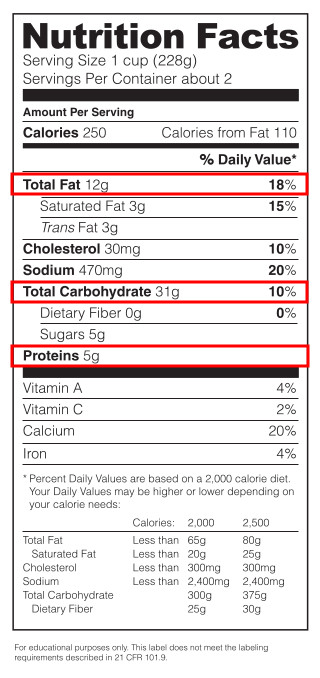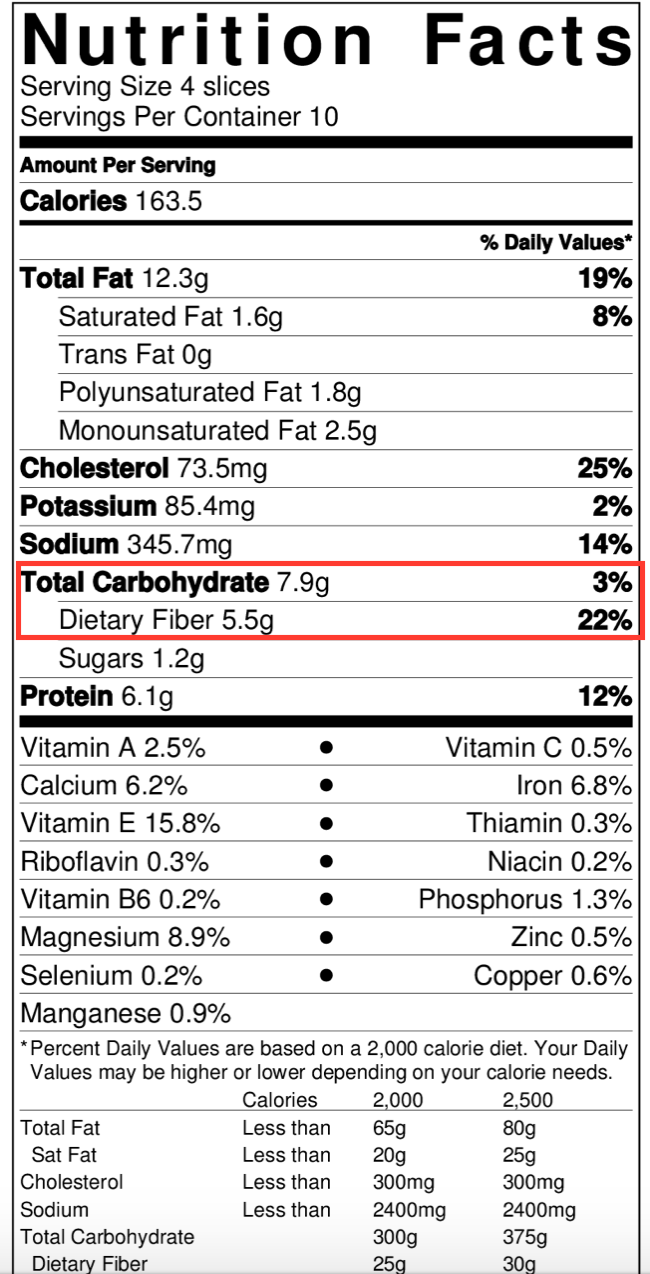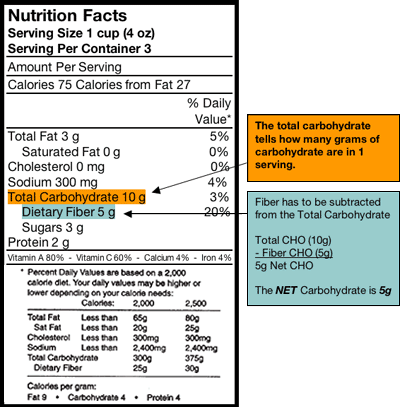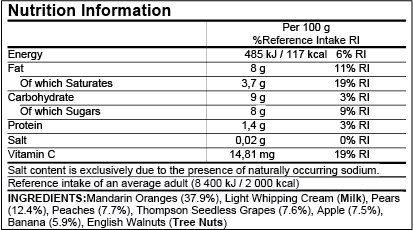44 carbohydrates on nutrition labels
How to Understand and Use the Nutrition Facts Label | FDA Feb 25, 2022 · Overview. The information in the main or top section (see #1-4) of the sample nutrition label (below) can vary with each food and beverage product; it contains product-specific information ... PDF Using Nutrition Labels: Carbohydrate Using Nutrition Labels: Carbohydrate Serving Size Look at the serving size. All the information on the label is based on this portion. Servings Per Container The number of servings contained in the package. Guidelines for Carbohydrate Look at the total grams of carbohydrate in the serving size. 1 carbohydrate choice = 15 grams of carbohydrate.
How To Read Nutrition Labels For Carbs - Montalvospirit On a nutrition food label, the total carbohydrate includes the sugar. Some Nutrition Facts labels may also list sugar alcohols under total carbohydrate. Should I count carbs or net carbs? The exact number of grams (g) of carbohydrates will be different for everyone, but is generally around 20 to 50 g per day. Many people on a keto diet count ...

Carbohydrates on nutrition labels
Low Carb Guide to Understanding Nutrition Labels This is a low carbohydrate, high fat nutrition plan, so while there are many things to be aware of when reading labels, total carbohydrate content is the most important. Let's walk through reading a Nutrition Facts label, from top to bottom. Learning To Read Labels :: Diabetes Education Online The grams of sugar listed include both natural sugars, from fruit or milk, and added sugars. On a nutrition food label, the total carbohydrate includes the sugar. Some Nutrition Facts labels may also list sugar alcohols under total carbohydrate. Sugar alcohols may be found in products that are labeled "sugar-free" or "no sugar added." Federal Register :: Food Labeling: Revision of the Nutrition ... May 27, 2016 · The comment also stated that the 2012 IOM report on front-of-pack labeling (Ref. 2) found that “a lack of nutrition knowledge is a major barrier to effective use of the [Nutrition Facts label] and may actually lower the motivation of some consumers to use the nutrition information on the label,” and that “some racial groups . . . are less ...
Carbohydrates on nutrition labels. PDF Read the Food Label for Carbohydrates Read the Food Label for Carbohydrates Food labels help you choose foods that are lower in calories and in carbohydrates and sweeteners. Here is a food label for a 12-ounce regular soda. The label provides lots of useful information. 1. Serving Size and Number of Servings The serving size is 12 ounces. There's 1 serving in this container. 2. Nutrition Facts Label: Carbohydrates | Conagra Nutrition Carbohydrates come in three main forms: starch, sugar, and fiber. When foods contain carbohydrates, they're often a mix of these forms. In packaged foods, the grams and types of carbohydrates are listed on the Nutrition Facts Label. Food Labels: Carbohydrates | Home & Garden Information Center According to nutrition experts, carbohydrates should provide 45-65% of your total daily calories. That means carbohydrates should supply 900 calories or more in a 2,000-calorie-a-day diet. Facts on Food Labels Food labels contain clues to a food's carbohydrate content, including the amount per serving. How To Read Nutrition Labels (Like a Pro) - Ditch The Carbs Carbohydrates will be on the nutrition label are often broken down into carbohydrates, sugars, starch, and fiber. However, each brand may display its nutritional contents differently. And depending on which country you are in they will either show NET or TOTAL carbs and sometimes it isn't clear which they are referring to.
How to Decode a Nutrition Label One common instance, says dietitian Diane Norwood, MS, RD, CDE, is that "Many people with diabetes go straight to sugars when they need to consider the total carbohydrate." Nutrition labels ... Understanding food labels | Diabetes UK Labels on the front don't include the amount of carbs, so check the label on the pack for the total carbohydrate, which includes carbohydrates from starchy food as well as sugars. The figures for sugars on traffic lights are for total sugars, which doesn't tell you how much of the sugar comes from natural sources, such as fructose and how ... Food Labels and Counting Carbs - dummies Total Carbohydrate is listed in grams. Because %Daily Value is written in bold and off to the right side of the label, and lined up neatly with the actual amount, it is easy to allow your eye to zero in on the %Daily Value rather than the actual amount in grams. How to Read Carbohydrates on Food Labels - GlycoLeap When learning how to read carbohydrates on food labels, always remember that 1 serving of carbohydrate is equal to 15 g of carbohydrates. If you want to have a snack, it is recommended to eat no more than 1 to 2 servings of carbohydrates in one sitting. That would be around 15 to 30 g of carbohydrates. Snack = 15 - 30 g of carbohydrate
Reading Food Labels | ADA Put food labels to work The Nutrition Facts labels on foods are really the key to making the best choices. We'll cover the basics so that these labels make shopping easier for you. Get started Understanding Carbs You've heard it all. From carb-free to low-carb, to whole and empty carbs, it's hard to know what it all means. Learn more How To Figure Out The Carbs On Nutrition Labels - Eat Out ... If more than one type of sugar alcohol is listed, there must be a line for sugar alcohol grams on the nutrition label. Other Carbohydrates shows the number of digestible complex carbohydrates not considered a sugar (natural or added) and includes additives like stabilizers and starchy thickening agents. They don't make it easy, do they? Save Reading food labels: Tips if you have diabetes - Mayo Clinic Less than 5 grams of carbohydrates a serving Do the math Pay attention to serving sizes. The serving sizes listed on food labels may be different from the serving sizes in your meal plan. If you eat twice the serving size listed on the label, you also double the calories, fat, carbohydrates, protein, sodium and other ingredients. How to Use the Nutrition Facts Label — Diet Doctor This chocolate has 14 grams of carbohydrates per serving. 3. Calculate net carbs per serving Third, check the grams of dietary fiber per serving (circled in green, above). Subtract the fiber (green) from the total carbohydrates (blue) to get the net carbs. This chocolate has 9 grams of net carbs per serving (14g carbs - 5g fiber = 9g net carbs).
Carb Counting #2: Nutrition Labels Total Carbohydrate reflects all sugars, including sugar, starch, fiber, and sugar alcohol. The "Sugar" listed under Total Carbohydrate is very misleading; all carbohydrate (sugar and starch) is included as part of "Total Carbohydrate." Be careful, it's easy to confuse the weight in grams of the food item with grams of Total Carbohydrate.
Understanding Food Nutrition Labels | American Heart ... When the Nutrition Facts label says a food contains "0 g" of trans fat, but includes "partially hydrogenated oil" in the ingredient list, it means the food contains some trans fat, but less than 0.5 grams per serving. So, if you eat more than one serving, you could end up eating too much trans fat.
Food Labels | CDC If you eat the whole thing, you are eating 8 times the amount of calories, carbs, fat, etc., shown on the label. Total Carbohydrate shows you types of carbs in the food, including sugar and fiber. Choose foods with more fiber, vitamins, and minerals. Choose foods with lower calories, saturated fat, sodium, and added sugars. Avoid trans fat.
What Is the Difference Between Sugar & Carbs on Food Labels? Each gram of carbohydrate and protein provides 4 calories, while a gram of fat provides 9 calories. Carbohydrates are found in a wide variety of foods, such as grain products, including bread, pasta, breakfast cereals, oatmeal, flours, crackers, starchy vegetables like potatoes and corn, legumes, milk, yogurt, fruits, juices, sugar and desserts.
Interactive Nutrition Facts Label Fact Sheets Nutrition Facts 4 servings per container Serving size 1 1/2 cup (208g) Amount Per Serving 240 Calories % Daily Value* 5% Total Fat 4g 8% Saturated Fat 1.5g Trans Fat 0g 2% Cholesterol...
Understanding Food Labels | The Nutrition Source | Harvard ... Under the Food Allergen Labeling and Consumer Protection Act of 2004, eight major food allergens—milk, fish, tree nuts, peanuts, shellfish, wheat, eggs, and soybeans—are required to be listed in a "contains" statement near the Ingredients list if present in a food. An example would be "contains wheat, milk, and soy."
Carbohydrates: Types & Health Benefits - Cleveland Clinic Carbohydrates — fiber, starches and sugars — are essential food nutrients that your body turns into glucose to give you the energy to function. Complex carbs in fruits, vegetables and whole-grain products are less likely to spike blood sugar than simple carbs (sugars).
How to Read Carbohydrates on Nutrition Labels|How to Read ... Breakdown of the Label If we break down the carbohydrates section of a nutrition label it usually has 3 parts. Carbohydrates -Sugars -Dietary fibre The top carbohydrates row is the total amount of carbs present. Made up of all the sugars, dietary fibre and starch, which is the remaining amount after the sugar and fibre.
Reading Food Labels for Carbohydrates - dummies Food labels are a fabulous resource for finding out how many carbohydrates are in your foods. You can use these labels to compare the carbohydrate content of different products and track the amount of carbohydrate you eat. Reading food labels is a vital skill for anyone who counts carbohydrates.
Carbohydrates: Uses, health benefits, nutrition, and risks Dec 17, 2020 · Carbohydrates are mainly found in plant foods. They also occur in dairy products in the form of a milk sugar called lactose. Foods high in carbohydrates include bread, pasta, beans, potatoes, rice ...
Do carbs on nutrition label include sugar ... On a nutrition food label, subtract the fiber from the total carbohydrate amount. When you read food labels, the grams of sugar are already included in the total carbohydrate amount, so you do not need to count this sugar amount separately.
What Do Total Carbohydrate And Added Sugar On The ... Trying to figure out the carbohydrates on nutrition facts labels can be downright confusing. There's a number for total carbohydrates but then there are subheadings for dietary fiber, sugars, and sometimes insoluble fiber, sugar alcohols, and other carbohydrates.
Topics | Nutrition.gov A locked padlock) or https:// means you've safely connected to the .gov website. Share sensitive information only on official, secure websites.
Carbohydrates: MedlinePlus Jan 17, 2022 · This amount can vary, depending on factors such as your age, sex, health, and whether or not you are trying to lose or gain weight. On average, people should get 45 to 65% of their calories from carbohydrates every day. On the Nutrition Facts labels, the Daily Value for total carbohydrates is 275 g per day. This is based on a 2,000-calorie ...
The New Nutrition Facts Label | FDA The U.S. Food and Drug Administration (FDA) has updated the Nutrition Facts label on packaged foods and drinks. FDA is requiring changes to the Nutrition Facts label based on updated scientific...
PDF What It Is - Food and Drug Administration Carbohydrate on the Nutrition Facts label includes: • Dietary fiber. is a type of carbohydrate made up of many sugar molecules linked together in such a way that it cannot be easily digested in the small intestine. Dietary fiber can increase the frequency of bowel movements, lower blood glucose and
Food Labels (for Teens) - Nemours KidsHealth Food labels provide more than just nutrition facts. They also tell you what's in a packaged food (i.e., the ingredients). People with food allergies need to check ingredient lists to avoid foods that can cause an allergic reaction. Some food labels also state which country the food came from, whether the food is organic, and certain health claims.
:max_bytes(150000):strip_icc()/LabelA2-56a5c0f65f9b58b7d0de5351.jpg)


/Untitled-design-1--5755c3703df78c9b46903dab.jpg)






:max_bytes(150000):strip_icc()/Untitled-design-5753677f5f9b5892e8d7d171.jpg)


Post a Comment for "44 carbohydrates on nutrition labels"